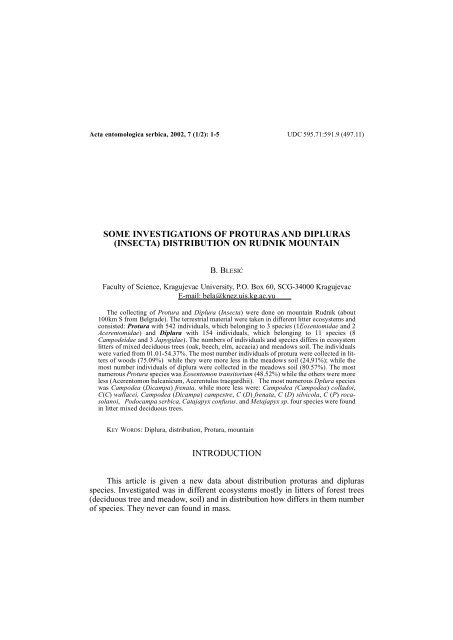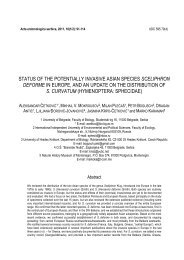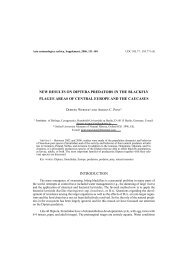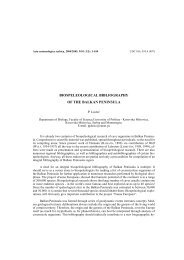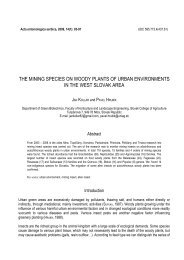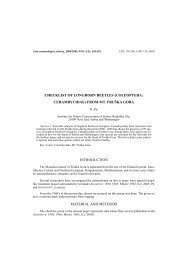some investigations of proturas and dipluras (insecta)
some investigations of proturas and dipluras (insecta)
some investigations of proturas and dipluras (insecta)
Create successful ePaper yourself
Turn your PDF publications into a flip-book with our unique Google optimized e-Paper software.
Acta entomologica serbica, 2002, 7 (1/2): 1-5 UDC 595.71:591.9 (497.11)<br />
SOME INVESTIGATIONS OF PROTURAS AND DIPLURAS<br />
(INSECTA) DISTRIBUTION ON RUDNIK MOUNTAIN<br />
B. BLESIĆ<br />
Faculty <strong>of</strong> Science, Kragujevac University, P.O. Box 60, SCG-34000 Kragujevac<br />
E-mail:bela@knez.uis.kg.ac.yu<br />
The collecting <strong>of</strong> Protura <strong>and</strong> Diplura (Insecta) were done on mountain Rudnik (about<br />
100km S from Belgrade). The terrestrial material were taken in different litter ecosystems <strong>and</strong><br />
consisted: Protura with 542 individuals, which belonging to 3 species (1Eosentomidae <strong>and</strong> 2<br />
Acerentomidae) <strong>and</strong> Diplura with 154 individuals, which belonging to 11 species (8<br />
Campodeidae <strong>and</strong> 3 Japygidae). The numbers <strong>of</strong> individuals <strong>and</strong> species differs in ecosystem<br />
litters <strong>of</strong> mixed deciduous trees (oak, beech, elm, accacia) <strong>and</strong> meadows soil. The individuals<br />
were varied from 01.01-54.37%. The most number individuals <strong>of</strong> protura were collected in litters<br />
<strong>of</strong> woods (75.09%) while they were more less in the meadows soil (24,91%); while the<br />
most number individuals <strong>of</strong> diplura were collected in the meadows soil (80.57%). The most<br />
numerous Protura species was Eosentomon transitorium (48.52%) while the others were more<br />
less (Acerentomon balcanicum, Acerentulus traegardhii). The most numerous Dplura species<br />
was Campodea (Dicampa) frenata, while more less were: Campodea (Campodea) colladoi,<br />
C(C) wallacei, Campodea (Dicampa) campestre, C (D) frenata, C (D) silvicola, C (P) rocasolanoi,<br />
Podocampa serbica,Catajapyx confusus. <strong>and</strong> Metajapyx sp. four species were found<br />
in litter mixed deciduous trees.<br />
KEY WORDS: Diplura, distribution, Protura, mountain<br />
INTRODUCTION<br />
This article is given a new data about distribution <strong>proturas</strong> <strong>and</strong> <strong>dipluras</strong><br />
species. Investigated was in different ecosystems mostly in litters <strong>of</strong> forest trees<br />
(deciduous tree <strong>and</strong> meadow, soil) <strong>and</strong> in distribution how differs in them number<br />
<strong>of</strong> species. They never can found in mass.
2<br />
Acta ent. serb., 2002, 7 (1/2): 1-5<br />
B. BLESIĆ: Distribution <strong>of</strong> Protura & Diplura on Rudnik Mountain<br />
MATERIAL AND METHODS<br />
The collecting <strong>of</strong> Protura <strong>and</strong> Diplura (Insecta) were done on mountain<br />
Rudnik (about 100km S from Belgrade) on 8 localities (Ugljarevac, Klisura,<br />
Ramaca, Taboriste, Dobraca, Poskurice, Sljivovac, Grbice). Seven hundred <strong>and</strong><br />
ninety tree (793) individuals were separated from samples on usual way. They<br />
belong in two order, four families <strong>and</strong> eleven species. On usually way them were<br />
collected <strong>and</strong> determined.<br />
RESULTS AND DISCUSSION<br />
The terrestrial material were taken in different litter ecosystems <strong>and</strong> consisted<br />
Protura with 542 individuals, which belonging to 3 species (1Eosentomidae<br />
<strong>and</strong> 2 Acerentomidae) <strong>and</strong> Diplura with 247 individuals, which belonging to 11<br />
species (8 Campodeidae <strong>and</strong> 3 Japygidae). The numbers <strong>of</strong> individuals <strong>and</strong><br />
species differs in ecosystem litters (<strong>of</strong> mixed deciduous trees, oak, beech, elm,<br />
accacia) <strong>and</strong> meadows soil. The individuals were varied from 01.01-54.37%. The<br />
most number <strong>of</strong> protura individuals were collected in litters <strong>of</strong> woods (75.09%)<br />
while they are more less in the meadows soil (24,91%).<br />
Investigated ordo Protura was represented with two families.<br />
Family Acerentomidae represented with two species <strong>and</strong> there are:<br />
1. Acerentomon balcanicum Ionescu, 1933 was found on four localities<br />
(Ramaca, Klisura, Grbice, Poskurice) in litter <strong>of</strong> mixture <strong>of</strong> deciduous trees, oak<br />
<strong>and</strong> acacia with 95 individuals.<br />
2. Acerentulus traegardhii Ionescu, 1937 was found on 5 localities<br />
(Ugljarevac, Ramaca, Sljivovac, Poskurice, Grbice) in litter <strong>of</strong> mixture <strong>of</strong> deciduous<br />
trees <strong>and</strong> meadow soil with 184 individuals.<br />
Family Eosentomidae represented with one species <strong>and</strong> that is:<br />
3. Eosentomon transitorium Berlese, 1908 was found on seven localities<br />
(Dobraca, Ramaca, Klisura, Taboriste, Ugljarevac, Sljivovac, Poskurice <strong>and</strong><br />
Grbice) in litter <strong>of</strong> mixture <strong>of</strong> deciduous trees <strong>and</strong> meadow soil with 263 individuals.<br />
The other investigated ordo Diplura was represented also with two followos<br />
families:<br />
Family Campodeidae are represented with eight species <strong>and</strong> there are:<br />
Campodea (Campodea) colladoi Silvestri, 1939 was found on two localities
Acta ent. serb., 2002, 7 (1/2): 1-5<br />
B. BLESIĆ: Distribution <strong>of</strong> Protura & Diplura on Rudnik Mountain 3<br />
(Ugljarevac <strong>and</strong> Taboriste) in meadow soil with 4 individuals.<br />
Campodea (Campodea) wallacei Bagnall, 1918 was found on 1 locality<br />
(Kamenicki Vis) in litter <strong>of</strong> beech trees with 6 individuals.<br />
Campodea (Dicampa) campestre Ionescu, 1955 was found on 7 localities<br />
(Leskovik, Dusnik, Resnik, Niska Banja, Sovariste, Lazarevo selo <strong>and</strong> Crnce) in<br />
litter <strong>of</strong>: mixture <strong>of</strong> deciduous trees, than oak <strong>and</strong> orchard trees, with 28 individuals.<br />
Campodea (Dicampa) frenata Silvestri, 1931 was found on 3 localities<br />
(Lazarevo selo, Kamenicki vis <strong>and</strong> Leskovik) in litter trees as: oak, beech <strong>and</strong><br />
orchard with 4 individuals.<br />
Campodea (Dicampa) malpighii Silvestri, 1912 was found on 4 localities<br />
(Dusnik, Gadzin Han, Ostrovica <strong>and</strong> Niska Banja) in litter <strong>of</strong>: mixture <strong>of</strong> deciduous<br />
trees, than oak <strong>and</strong> acacia, with 20 individuals.<br />
Campodea (Paurocampa) rocasolanoi Silvestri, 1932 was found on 1 locality<br />
(Ostrovica) in litter <strong>of</strong> acacia trees with 1 individual. The first finding <strong>and</strong> her<br />
description is from South <strong>of</strong> Greek, later also is known from Macedonia <strong>and</strong><br />
Montenegro (CONDE, 1984; BLESIC, 1998b,2001). So this finding is the most North<br />
in it distribution.<br />
We can say that this species is the species <strong>of</strong> Balkan.<br />
Campodea (Paurocampa) speleae Ionescu, 1955 was found on 1 locality<br />
(Kamenicki vis) in litter <strong>of</strong> beech trees with 10 individuals.<br />
Campodea (Paurocampa) suensoni Tuxen, 1930 was found on 4 localities<br />
(Resnik, Kamenicki vis, Ostrovica, Gadzin Han) in litter <strong>of</strong> mixture <strong>of</strong> deciduous<br />
trees, oak, beech <strong>and</strong> acacia with 49 individuals.<br />
Family Japygida are represented with three species <strong>and</strong> there are:<br />
Catajapyx confuses Silvestri, 1929 was found on 5 localities (Sovariste,<br />
Crnce, Lazarevo selo, Leskovik <strong>and</strong> Niska Banja) in litters <strong>of</strong> mixture <strong>of</strong> deciduous<br />
tree, oak <strong>and</strong> orchard trees with 30 individuals.<br />
Japyx solifugus Silvestri, 1933 was found on 1 locality, in litter <strong>of</strong> oak trees,<br />
with 1 individual.<br />
Metajapyx gojkovici Pages, 1953 was found.on 1 locality, in litter <strong>of</strong> beech<br />
trees with 1 individual.<br />
This is a new finding in their distribution (BLESIC, 1995).
4<br />
Acta ent. serb., 2002, 7 (1/2): 1-5<br />
B. BLESIĆ: Distribution <strong>of</strong> Protura & Diplura on Rudnik Mountain<br />
CONCLUSION<br />
In this investigation were found 696 individuals <strong>of</strong> Protura <strong>and</strong> Diplura<br />
(Insecta) were done on mountain Rudnik (about 100km S from Belgrade). The terrestrial<br />
material were taken in different litter ecosystems <strong>and</strong> consisted from:<br />
Protura with 542 individuals, which belonging to 3 species (1 to family<br />
Eosentomidae <strong>and</strong> 2 to Acerentomidae) <strong>and</strong> Diplura with 154 individuals, which<br />
belonging to 11 species (8 to Campodeidae <strong>and</strong> 3 to Japygidae). The numbers <strong>of</strong><br />
individuals <strong>and</strong> species differs in ecosystem litters <strong>of</strong> mixed deciduous trees (oak,<br />
beech, elm, accacia) <strong>and</strong> meadows soil. The individuals were varied from 01.01-<br />
54.37%. The most number <strong>of</strong> protura individuals were collected in litters <strong>of</strong> woods<br />
(75.09%) while they are more less in the meadows soil (24,91%). The most number<br />
<strong>of</strong> diplura individuals were collected in the meadows soil (80.57%). The most<br />
numerous Protura species was Eosentomon transitorium (48.52%) while the others<br />
were more less (Acerentomon balcanicum, Acerentulus traegardhii). The<br />
most numerous Dplura species was Campodea (Dicampa) frenata while more<br />
less were: Campodea (Campodea) colladoi, C(C) wallacei,Campodea (Dicampa)<br />
campestre, C (D) frenata, C (D) silvicola, C (P) rocasolanoi, Podocampa serbica,<br />
Catajapyx confusus <strong>and</strong> Metajapyx sp. four species were found in litter<br />
mixed deciduous trees.<br />
AKNOWLEDGEMENTS<br />
The investigation was partly financially support by a grant No 1563 from the<br />
Serbian Ministry <strong>of</strong> Science <strong>and</strong> Tehnologies.<br />
REFERENCES<br />
BLESIC, B. 1998a. Investigation <strong>of</strong> Protura <strong>and</strong> Diplura <strong>of</strong> South Serbia. . Proceedings for<br />
Natural Sciences, Matica Srpska, Novi Sad, 94: 87-90.<br />
BLESIC, B. 1998b. Knowledge <strong>of</strong> Protura <strong>and</strong> Diplura <strong>of</strong> Montenegro. The Montenegrin<br />
Academy <strong>of</strong> Science <strong>and</strong> Arts – Glasnik <strong>of</strong> the section <strong>of</strong> Natural Sciences, Podgorica<br />
12: 63-70.<br />
BLESIC, B. 2000. Investigation <strong>of</strong> Diplura <strong>and</strong> Protura in Western Serbia. Proceedings for<br />
Natural Sciences, Matica Srpska, Novi Sad, 99: 69-79.<br />
BLESIC, B. 2001. Protura <strong>and</strong> Diplura (Insecta: Apterygota) <strong>of</strong> the Republic <strong>of</strong> Macedonia.<br />
75years Macedonian Museum <strong>of</strong> Natural History, Skopje, :157-162.
Acta ent. serb., 2002, 7 (1/2): 1-5<br />
B. BLESIĆ: Distribution <strong>of</strong> Protura & Diplura on Rudnik Mountain 5<br />
НЕКА ИСТРАЖИБАНЈА ДИСТРИБУЦИЈЕ PROTURA И<br />
DIPLURA ПЛАНИНЕ РУДНИК<br />
Б. БЛЕСИћ<br />
И З ВОД<br />
Прикупљање материјала Protura и Diplura (Insecta) обављено је на<br />
планини Рудник (око 100км Ј од Београда). У материјалу узетом у<br />
стељи раѕличитих екосистема има: Protura 524 јединке које припадају<br />
трима врстама (једна породици Eosentomidae и две породици<br />
Acerentomidae) и Diplura 154 јединки које припадају у једанаест врста<br />
(осам породици Campodeidae и три Japygidae). Бројеви јединки и<br />
врста се разликују у стељама различитих екосистема (мешовитог<br />
листопадног дрвећа, храста, букве, граба, багрема) и у ливадским<br />
земљиштима. Број јединки варирао је од 01.01’54.37%. Највећи број<br />
јединки протура је био у шумским стељама (75.09%) док су манје<br />
бројне у ливадским земљиштима (24,91%). Јединке диплура су у<br />
највећем броју установљене у ливадким земљиштима (80,57%).<br />
Најбројнија међу протурама је врста Eosentomon transitorium (48,52%)<br />
а остале су у мањем броју констатоване (Acerentomon balcanicum,<br />
Acerentulus traegardhii). Међу диплурама је најбројнија врста<br />
Campodea (Dicampa) frenata. Четири врсте су нађене у стељи<br />
мешовитог листопадног дрвећа. Знатно су мање биле заступлјене<br />
врсте: Campodea(Campodea) colladoi, C (C) wallacei, Campodea<br />
(Dicampa) campestre, C (D) frenata, C (D) silvicola, C(P) rocasolanoi,<br />
Podocampa serbica, Catajapyx confusus и Metajapyx sp.<br />
Received November 15, 2003<br />
Accepted December 10, 2003


